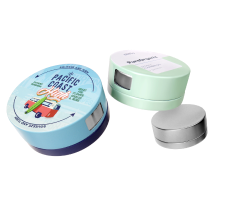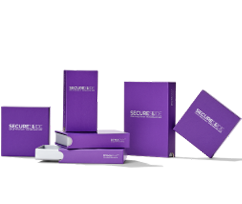Small Packaging Uses You Never Thought About
The phone you’re using now came with a small box that housed the smartphone, earphones, charger, and USB cable. You’re also likely to see earrings, necklaces, rings, jewelry boxes, and other loose jewelry in a tiny box mailer.
Small packaging not only involves custom packaging boxes but other materials too. This article discusses various types of small shipping boxes and their uses.
What Are the Different Types of Small Packaging?
Shrink Wrap
Shrink wraps are primary and secondary packaging supplies for small products like notebooks and CD cases. In addition to keeping small packaging boxes together, bubble wrap shrink wraps and bubble mailers also provide abrasion and puncture protection, cushioning, and impact resistance.
Since the material is plastic, shrink wraps are cheaper than corrugated cardboard boxes. These shipping protection options take up less space inside bulky corrugated shipping boxes over cardboard inserts and offer more protection than tissue paper or white kraft paper.
Vacuum Packaging
Vacuum packaging is an excellent option for items that require sealing, making it an excellent option for perishable products. Since they’re compact, they’re also perfect for dehydrated goods or food intended for backpacking or camping trips.
This packaging removes oxygen from the food, keeping out bacteria, yeast, and mold. Vacuum packaging is better at keeping foods fresh for longer in the freezer than other materials. It’s also ideal for medical supplies requiring hermetic sealing.
Molded Pulp Packaging
Molded pulp is a sustainable and versatile product packaging. It is popular for holding cups from fast-food restaurants and can be shaped into trays, sheets, and clamshells to hold other fragile items. That’s because it’s heat resistant, durable, high-quality and can withstand impact.
A metal mold is used to form paper pulp into your desired shape, making it suitable for unique designs. The packaging can be recycled and made from recycled paper and cardboard. It’s also biodegradable and compostable, making it greener than most other packaging options.
Flexible Pouches
Flexible pouches are popular in the food and beverages industry and can be seen on supermarket shelves. They package nuts, coffee, granola, energy drinks, soups, and other food products.
Their e-commerce best seller popularity can be attributed to the fact that they’re resealable. They’re also less costly to manufacture, ship and store than cardboard, metal, paperboard, and glass, and their environmental impact is low.
Standard Plastic Packaging: What Are the Downsides?
Low Melting Point
Plastic has a lower melting point than other packaging materials. Hence, plastic packaging solutions cannot survive in a hot area, such as a furnace.
Also, some plastic materials like polyesters, acrylics, nylons, and polyethylene are highly flammable and fire hazards. That’s why the materials are suitable for home appliances and office supplies.
Not Eco-Friendly
Plastics are non-degradable and can take centuries to decompose because of the powerful bonding of intermolecular forces.
Plastics are washed away by rivers and streams, clogging natural water sources and sucking out oxygen from marine ecosystems. When exposed to sunlight, plastics emit greenhouse gasses.
Not Durable
Plastics are less durable than metal packaging materials. This is a significant cause of plastic pile-up in landfills. Regardless of the amount of recycled and reused plastics, a considerable amount ends up in oceans and dumpsites.
They’re also very light and can easily be moved by wind, making it hard to collect all plastics for recycling.
Harmful to Nature
Plastic is made from petroleum and contains many chemicals in the form of stabilizers and colorants harmful to animals and plants. What’s more, animals die from choking on plastics.
When plastics suck out oxygen in oceans, marine wildlife dies, threatening entire species.
Why Child-Resistant Bags Are the Way to Go
The primary reason for child-resistant bags is to keep children safe from potentially harmful products. Many household products are dangerous to children, such as medicine, bleach, and cannabis edibles when consumed.
Using child-resistant packages also ensures you’re free from liability, and consumers trust your brand more, offering you more sales. These bags also help keep oxygen and humidity out, prolonging the quality of the products and maintaining their taste, freshness, and odor.
Opaque child-resistant bags allow consumers to hide the identity of the bag’s contents, which makes it easy to keep them away from the children. Moreover, resealable child-resistant bags are sustainable since they are used multiple times and can be cleaned and refilled with new products.
What Can You Do with Child-Resistant Bags?
Numerous products require child-resistant bags. According to the Consumer Product Safety Commission (CPSC), pharmaceutical products with specific amounts of aspirin, ibuprofen, acetaminophen, elemental iron, and naproxen require child-resistant bags.
Other products that require child-resistant bags include dietary supplements and multivitamins, cannabis goods, batteries, sharp objects, and cosmetic products.
Storing Batteries Safely
Coin lithium batteries are used in everyday items such as remote controls, flameless candles, calculators, cameras, watches, children’s audiobooks, and keyless car entry devices. These batteries can result in severe chemical burns if ingested.
When a small child swallows a coin lithium battery, it can get stuck in the food pipe. The saliva activates an electric current, and the esophagus may start to burn in as little as two hours. As a result, this throat tissue injury can lead to vocal cord paralysis, numerous surgeries, and tube feeding.
Therefore, in addition to storing batteries out of reach of children, ensure you buy from brands that use child-resistant bags. According to the National Capital Poison Center, CPSC compliant child-resistant flexible packaging can avoid 11% of coin lithium battery ingestions.
Keeping Kids Safe From Sharp Objects
Children can succumb to sharp objects, including knives, forks, nails, pens, pencils, razor blades, and scissors. Children can easily hurt themselves, and it’s essential to keep these objects in a drawer out of their reach. However, having child-resistant packaging for these items is even more important.
Protecting Your Hemp
Children have a sweet tooth, and they easily mistake hemp gummies from the dispenser for regular ones. But unfortunately, edibles are more potent and have prolonged effects, primarily on kids, due to their smaller weight and size.
Children who experience cannabis intoxication require immediate hospital admission. Symptoms include loss of coordination, breathing problems, and drowsiness.
Therefore, keep your hemp products on high shelves and store them in child-resistant packaging. Also, buy your hemp products from a brand that uses child-resistant bags.
Safe Storage for Cosmetics and Personal Care
Cosmetics are toxic when ingested in large amounts. For instance, lipstick has lead, which is toxic with severe health consequences. It negatively affects the kidneys, bones, heart, brain, and gut.
Other beauty products like powders, fragrances, lotions, and nail polish have lead, asbestos, and phthalates. Using child-resistant packaging with cosmetics is crucial to keeping children safe at home.
For instance, most lipsticks have a two-step child-resistant system where the consumer pulls out the lid before rotating the item’s base to access the beauty product.
Child-Resistant Medicine and Vitamin Tins
High levels of consumption of over-the-counter medicine can harm children. For instance, massive amounts of acetaminophen can cause liver failure and liver damage. If they overdose on cough and cold medicine, they may experience seizures and other severe side effects.
That’s why medicine tablets will come in a blister pack as a primary packaging that allows consumers to access their pills easily. A child cannot access the medications, making the packaging highly efficient.
A secondary packaging, an opaque box, is used to hide the identity of the contents and keep children safe. Child-resistant tins are also efficient for storing medicine tablets safely.
Summary
From cupcake bakery boxes to storage boxes to gift packaging, the packaging is essential for running your small business. The integrity and safety of a product depend on the quality of the packaging and packing boxes.
Child-resistant packaging is also essential for keeping children safe from sharp objects, hemp products, medicine, and batteries.
Whichever packaging you use, ensure it’s compliant with CPSC’s child-resistant regulations. Consequently, you’ll enjoy customer loyalty, increased sales, and no liability.
Check out our child-resistant mylar bags that keep products safe and consumers safer, and get a custom quote today!
Sources
Lead In Lipstick | Safe Cosmetics
Accidental Acute Cannabis Intoxication Presenting as Seizure in Pediatrics Patients | PMC
Plastic Production and Decomposition | Plastic Soup Foundation
Marijuana Effects On Children | Children’s Hospital Colorado



